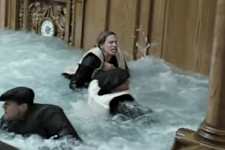The frigid conditions have resulted in three deaths thus far, and AccuWeather meteorologists say the travel-snarling snowstorm is far from over.
By Alex Sosnowski, AccuWeather senior meteorologist
Published Dec 23, 2022 11:50 AM EST | Updated Dec 24, 2022 4:22 PM EST
The same powerful storm that brought blizzard conditions and severe cold to a large portion of the central United States has generated a major lake-effect snow event into the Christmas weekend. Conditions have turned deadly, with three fatalities reported in the greater Buffalo area as of Saturday.
On Saturday morning, two fatalities from the storm were announced by Erie County Executive Mark Poloncarz, with both occurring in Cheektowaga, about 7 miles east of downtown Buffalo. The deaths were categorized as "emergency medical events that responders could not get to." A third death was reported Saturday afternoon, as a body was found in the city, according to a Buffalo police spokesperson. Poloncarz added that Erie County, New York, where Buffalo is located, is "preparing to encounter more fatalities" as search and rescue missions continue throughout the day.
Members of the National Guard were out in Erie County Saturday morning working to get people out of stranded cars, targeting the hardest-hit areas including Buffalo and the surrounding northtowns.

HAMBURG, NY - DECEMBER 23: A member of the media battles snow and ice as Lake Erie waters wash over the shoreline on December 23, 2022 in Hamburg, New York. (Photo by John Normile/Getty Images)
During Friday and overnight Saturday, local first responders and emergency equipment were unable to reach hard-hit spots, including Buffalo, unable to "even go a few blocks" according to Poloncarz. "Getting first responders back online is our top priority," he said.
"In Buffalo, this storm will likely at least jump near the top of the list of worst blizzards in the city’s history, if not even becoming the worst," AccuWeather Meteorologist Jake Sojda said. "Four to 6 feet of snow will fall by Sunday and coupled with wind gusts approaching hurricane force [74 mph or greater] to create enormous drifts and impossible travel."
A blizzard is defined by the National Weather Service as sustained or wind gusts to 35 mph or greater with visibility of one-quarter of a mile or less in snow or blowing snow for at least three consecutive hours.
The storm began as a rain event for Buffalo, with the city receiving 1.98 inches on Friday, breaking the prior daily record of 1.73 inches that had stood since 1878. As Arctic air rushed in, however, rain changed to heavy snow Friday morning. The Buffalo airport recorded zero-mile visibility for nearly 16 hours from midday Friday to the early morning hours of Christmas Eve.
"One of the most extensive, most intense blizzards I've ever covered," Extreme Meteorologist Reed Timmer said amid the snowstorm.

Reed Timmer braves the epic blizzard and Arctic cold in Buffalo, New York, late Friday, Dec. 23, 2022.
"Just a feeling out here of helplessness not being able to see anything, losing your sense of up versus down," Timmer explained as the wind-driven snow howled around him.
Friday's total snowfall ended at a record of 22.3 inches in the city, nearly doubling up the previous daily maximum snowfall record of 12.6 inches set in 1976. A total of 28.1 inches of snow has been recorded so far at the airport as of Saturday afternoon.
A blizzard warning remains in effect for the metro area until 7 a.m. EST Sunday as an intense lake-effect band will persist downwind of Lake Erie into Christmas Day. The conditions forced a closure of Buffalo Niagara International Airport until at least 11 a.m. EST Monday, per New York Gov. Kathy Hochul.

Lake Erie waters wash over the shoreline on December 23, 2022 in Hamburg, New York. The Buffalo suburb and surrounding area are expecting wind gusts over 70 miles per hour battering homes and businesses throughout the holiday weekend. (Photo by John Normile/Getty Images)
"Power outages are possible across the City of Buffalo and the Western New York region throughout the duration of the storm," Buffalo Mayor Byron W. Brown said in a press conference earlier this week. As of Saturday morning, over 30,000 customers are without power in Erie County.
During the Blizzard of '77, high winds helped to blow snow from the then-frozen Lake Erie onto the shoreline and into Buffalo from late January to early February. Mountainous drifts occurred.
In the current situation, the lake is not yet frozen over, but the open waters can fuel a tremendous amount of lake-effect snow, considering the frigid conditions in the single digits and teens F much of the time.
More recently, the snow event from mid-November brought a storm total of 81.2 inches in Hamburg and 80 inches in Orchard Park, New York. These locations are towns south of Buffalo. However, the band of heaviest snow with this latest event has aimed farther north, bringing extensive impacts to the downtown area and some of the towns on the Niagara Peninsula.
"The heavy snow across the Great Lakes will be coupled with roaring winds," Sojda said. "Blizzard conditions could persist for over 48 hours in some areas downwind of the Great Lakes. Significant blowing and drifting is expected and will make measuring snow very difficult."

In some cases, it will be nearly impossible to know exactly what the snow totals are due to extreme drifting of snow.
"Even areas around the Great Lakes that don’t receive much snow can experience whiteout conditions at times, especially in open areas," Sojda said.
Anyone that attempts to venture out and travel amid the storm will face a high risk of becoming stranded and buried in snow.
In the heaviest snow bands that set up off the Great Lakes, snowfall rates of 6 inches per hour can occur. The exceptional rate of snow may last for many hours. When combined with the high winds and powdery nature of the snow, massive drifts deep enough to cover single-story homes and completely bury vehicles are likely.
Where the power goes out, "people could be stuck in homes with no heat or running water," Sojda said. There is the risk that exhaust pipes from those stuck in cars or homes could become blocked, which can substantially increase the risk of carbon monoxide poisoning.

Feet of snow will also pile up to the east of Lake Ontario this Christmas weekend as well, where conditions very similar to that of Buffalo are likely in some communities.
The western Great Lakes will certainly get their fair share of lake-effect snow through the holiday weekend as well, Sojda said.
"One to two feet is likely by Sunday in western Michigan near the lakeshore. Some parts of northern Lower Michigan and the Upper Peninsula can see as much as 2 to 4 feet where heavy snow is the most persistent," he said.
The amount of snow that falls around the Great Lakes, especially off of lakes Erie and Ontario, may require heroic means to remove for some communities to have access to highways and emergency services in the days ahead. It could take days for some neighborhoods to dig out.
Fortunately, the weather will begin to cooperate after this weekend with a day-to-day warming trend and a break from major storms coming next week. Temperatures will climb well above freezing across a large area of the country later next week and for the New Year's weekend.
More to read:
Want next-level safety, ad-free? Unlock advanced, hyperlocal severe weather alerts when you subscribe to Premium+ on the AccuWeather app. AccuWeather Alerts™ are prompted by our expert meteorologists who monitor and analyze dangerous weather risks 24/7 to keep you and your family safer.


![[Gallery] the Most Gigantic Animals That Shouldn't Exist but Do](https://images.revcontent.com/revcontent/image/fetch/f_jpg,q_auto,h_150,w_225,c_fill,g_face:auto/pg_1/https://media.revcontent.com/content/images/f65ede3770db1112204269d1308502f7.jpeg)



No comments:
Post a Comment